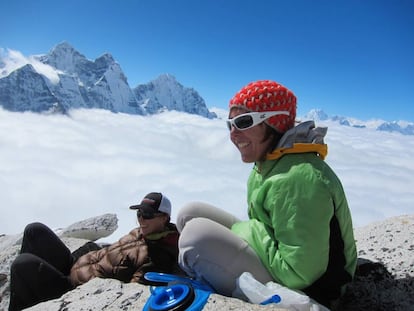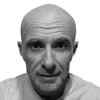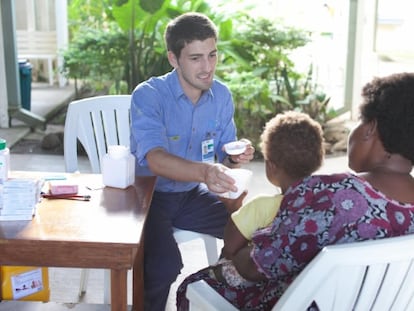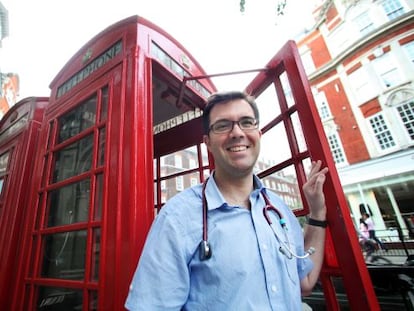The Spanish doctor with a surgery on Mount Everest
Mónica Piris has been working since 2007 to help climbers injured trying to scale the world’s highest peak

She looks as though she’s waiting behind enemy lines to pick up the pieces in a war zone. In fact, Spanish doctor Mónica Piris is on hand at a base camp to treat the war wounds of climbers battling Mount Everest. She has been here for the past month and, in that time, more than 400 people have reached the summit, though it hasn’t all been victory. Five died this year and a large number had to be rescued due to exhaustion, blindness, pulmonary edema and frostbite.
“There have been a huge number of frostbite cases on the south face this year,” says Piris. “Last month, there were almost 200 people trying to reach the summit from that side. A lot of them spent up to 20 hours on the mountain in bad weather and many suffered frostbite and needed to be evacuated by helicopter from camp II.”
Born in Oxford to Spanish parents and fiercely proud of her Spanish identity, Piris started working at high altitude on Everest in 2007 and later that year on another of the world’s highest peaks, Cho Oyu. Since then she has set up her clinic every autumn on Manaslu (8,163 m), Makalu (8,485m) and Ama Dablam (6,812m). In total, she spends between four and five months a year at the base camp of some of the world’s tallest mountains. The Tibetan Everest base camp, however, is proving a challenge.
Zombie camp
“The Everest base camp in Nepal is at 5,300 meters. It's high but you can live reasonably well there,” says Mónica. “But the Everest Advanced Base camp, on the Tibetan side, is at 6,400m.”
It’s also known as the zombie camp, because it feels abandoned and lifeless. “In the morning when the sun is out, you sometimes see someone outside but after 1pm hardly anyone leaves their tent or the dining tent. This year, the weather is even more unpleasant than usual. We have been in a bad weather cycle for 10 days – the sky gets cloudy and it starts to snow and it gets colder and more humid.”
At altitudes of 5,500m or 6,000m, almost everybody goes into physical and mental decline
Mónica Piris
Here, the only brake on physical deterioration is the determination of those aspiring to reach the roof of the world. “At altitudes of 5,500m or 6,000m, almost everybody goes into physical and mental decline,” says Mónica. “You lose your appetite, you lose weight, you lose the desire to do anything and you can’t sleep deeply like you can at sea level. Your skin, lips, nose, throat and lungs go dry. You get sores on your mouth and your fingers. You lose the level of physical fitness you attained in the run-up to the expedition. Personally after a season at ABC (Advanced Base Camp), I always feel weak and ugly,” she says with a laugh, before adding that the deterioration accelerates at 7,000m and beyond. “Unforeseen exposure can happen when there’s an accident or when you are surprised by bad weather: frostbite sets in fast, then hypothermia, brain damage and finally death,” she explains.
Mónica Piris currently works for Alpenglow, a company that offers guided expeditions up some of the most challenging mountains in the Himalayas. The company is among the more expensive players, but there are plenty to choose from, says Piris. “For €15,000, you get the permit and basic base camp facilities, including a cook,” she explains. “That’s it. Those who pay €100,000 get a maximum support team, including a private UIAGM-certified guide, one or two sherpas per person – well-paid and totally insured, a base camp equipped with an internet connection, heaters, imported food, medical aid, unlimited oxygen and helicopter transfer to the base camp. These are the two extremes: then you have everything in between.”
It might sound like a cliché, but the fact is that many climbers on Everest need to be guided, supported and sometimes even pushed to the top. The surprising lack of independence among them explains the number of companies working this market niche. Of course, the need for bottled oxygen makes the companies practically indispensable. “In Alpenglow, the clients climbing Everest’s North face start oxygen at 7,000m,” says Piris. “Before they go for the summit, they do acclimatize with several nights at 7,000 meters on the North Ridge. But there are groups climbing Everest from the south that start oxygen at 6,400 meters, when they leave camp II. I have even seen climbers using oxygen as soon as they leave base camp but that’s not common.”
In total, Mónica Piris spends between four and five months a year at the base camp of some of the world’s tallest mountains
Bottled oxygen is the star of Doctor Piris’s medical supply kit, but she has a wide variety of ailments to treat. “Altitude sickness is common,” she says. “Swelling in the brain and the lungs are less frequent but they always appear sooner or later. And then there are problems unrelated to altitude, such as colds, respiratory or gastric infections. At least once an expedition, I treat someone with something more serious, such as acute abdominal pain, angina or a mini-stroke. Complaints triggered by the climate are not serious but they are very uncomfortable and often mean a number of consultations, like a dry cough, blocked nose, cracked fingertips. Then there are the injuries from rock falls, common on the Lhotese face of Everest, ice falls more frequent on the south side of Everest and avalanches that are a feature of Manaslu.”
Weeks before each expedition, Piris compiles a list of medicines that will cover not only clients but also guides, sherpas, cooks and herself. It is also her job to ensure each camp on the mountain has a complete first-aid kit.
Daily life at base camp
The prospect of being stationed at base camp over a period of time is a daunting one. Not only does the team there deal with oxygen deficiency, freezing temperatures, and rudimentary sleeping conditions, but they have to contend with mind-numbing boredom. To keep her busy when the clients, guides and sherpas are further up the mountain, Piris mans the radio, noting down schedules, weather conditions and what other people on the mountain are saying.
When clients are trying for the summit itself, which can take up to five days, she is on radio duty around the clock. This last push for the summit is a tense and uncertain time for Piris, when she must be prepared for any medical contingency. “I am constantly documenting the progress of our climbers, the time they’re taking, the oxygen that is left to them, etc. It’s very intense. I have to become the coordinator. When the groups are up at high altitude, it is very important to document everything and have ideas and schedules very clear.”
But although she tries to stay one step ahead to prevent disaster, she recognizes that she can’t anticipate everything. “In 2012, one of the sherpas working for us suddenly collapsed coming down from camp I to base camp,” she recalls.
It is a stressful business and not a job for all seasons. In the summer, Mónica lives in Beranga in northern Spain, and spends her winters in Chamonix with German climber David Goettler, whose reputation in the Himalayas is well known in mountaineering circles. And once a month she works in a hospital in Oxford.
Would the climbers she meets in the Himalayas pass the kind of doping test they do on cyclists? “Some would and some wouldn’t,” she says with a smile.
English version by Heather Galloway.
Sign up for our newsletter
EL PAÍS English Edition has launched a weekly newsletter. Sign up today to receive a selection of our best stories in your inbox every Saturday morning. For full details about how to subscribe, click here.
Tu suscripción se está usando en otro dispositivo
¿Quieres añadir otro usuario a tu suscripción?
Si continúas leyendo en este dispositivo, no se podrá leer en el otro.
FlechaTu suscripción se está usando en otro dispositivo y solo puedes acceder a EL PAÍS desde un dispositivo a la vez.
Si quieres compartir tu cuenta, cambia tu suscripción a la modalidad Premium, así podrás añadir otro usuario. Cada uno accederá con su propia cuenta de email, lo que os permitirá personalizar vuestra experiencia en EL PAÍS.
¿Tienes una suscripción de empresa? Accede aquí para contratar más cuentas.
En el caso de no saber quién está usando tu cuenta, te recomendamos cambiar tu contraseña aquí.
Si decides continuar compartiendo tu cuenta, este mensaje se mostrará en tu dispositivo y en el de la otra persona que está usando tu cuenta de forma indefinida, afectando a tu experiencia de lectura. Puedes consultar aquí los términos y condiciones de la suscripción digital.











































